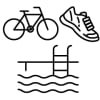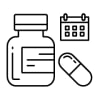Prediabetes is a warning sign that you're at risk for getting type 2 diabetes. It means that your blood sugar is higher than it should be. But it's not high enough to be diabetes.

Your body turns food into sugar (glucose), which you need for energy. When you have prediabetes, sugar builds up in your blood. This raises your blood sugar.

You can do things to help lower your blood sugar, like being active. Making small changes to the way you eat can help too.
How can you care for yourself at home?
Here are some things you can do to help prevent or delay type 2 diabetes.

Stay at a weight that’s healthy for you. Talk to your doctor if you need help with this. Even a small amount of weight loss can help.

Make healthy food choices. Limit calories, sweets, and unhealthy fats. Eat more vegetables, whole grains, and lean proteins.

Get at least 30 minutes of exercise on most days. For many people, walking is a good choice. Or you may want to swim, bike, or do other activities.

If you smoke, try to quit. If you can’t quit, cut back as much as you can. Talk to your doctor if you need help quitting.

Take your medicines as prescribed. Tell your doctor if you're having problems with medicines.
When should you call for help?

Watch closely for changes in your health, and be sure to contact your doctor if:
- You have any symptoms of high blood sugar. These may include:
- Being thirsty more often.
- Urinating more.
- Being hungrier.
- Losing weight without trying.
- Being very tired.
- Having blurry vision.
- You have a wound that will not heal.
- You have an infection that will not go away.
- You have problems with your blood pressure.
- You want more information about diabetes and how you can keep from getting it.
Follow-up care is a key part of your treatment and safety. Be sure to make and go to all appointments, and call your doctor if you are having problems. It's also a good idea to know your test results and keep a list of the medicines you take.
Where can you learn more?
Go to http://www.healthwise.net/patientEd
Enter I222 in the search box to learn more about "Prediabetes: Care Instructions".
Current as of: October 2, 2023
Author: Healthwise Staff
Clinical Review Board
All Healthwise education is reviewed by a team that includes physicians, nurses, advanced practitioners, registered dieticians, and other healthcare professionals.

